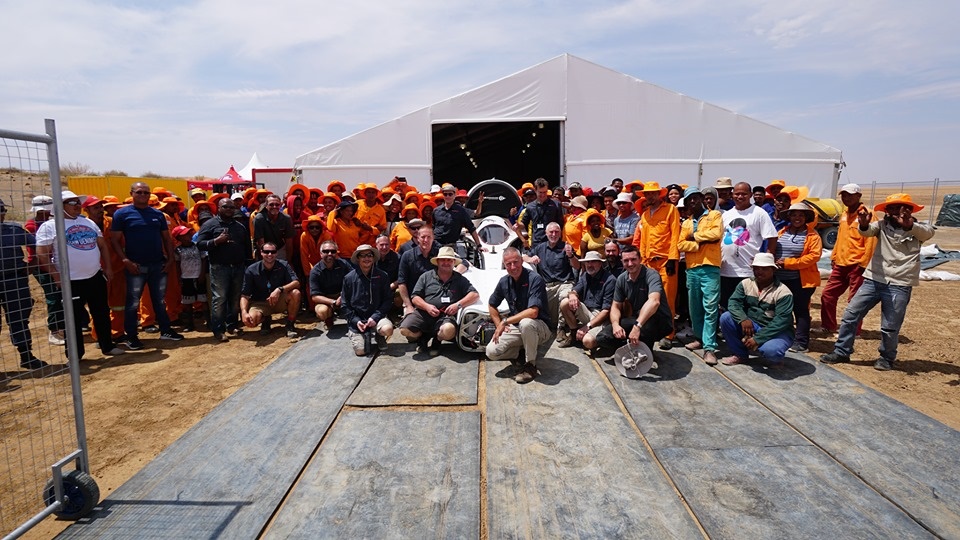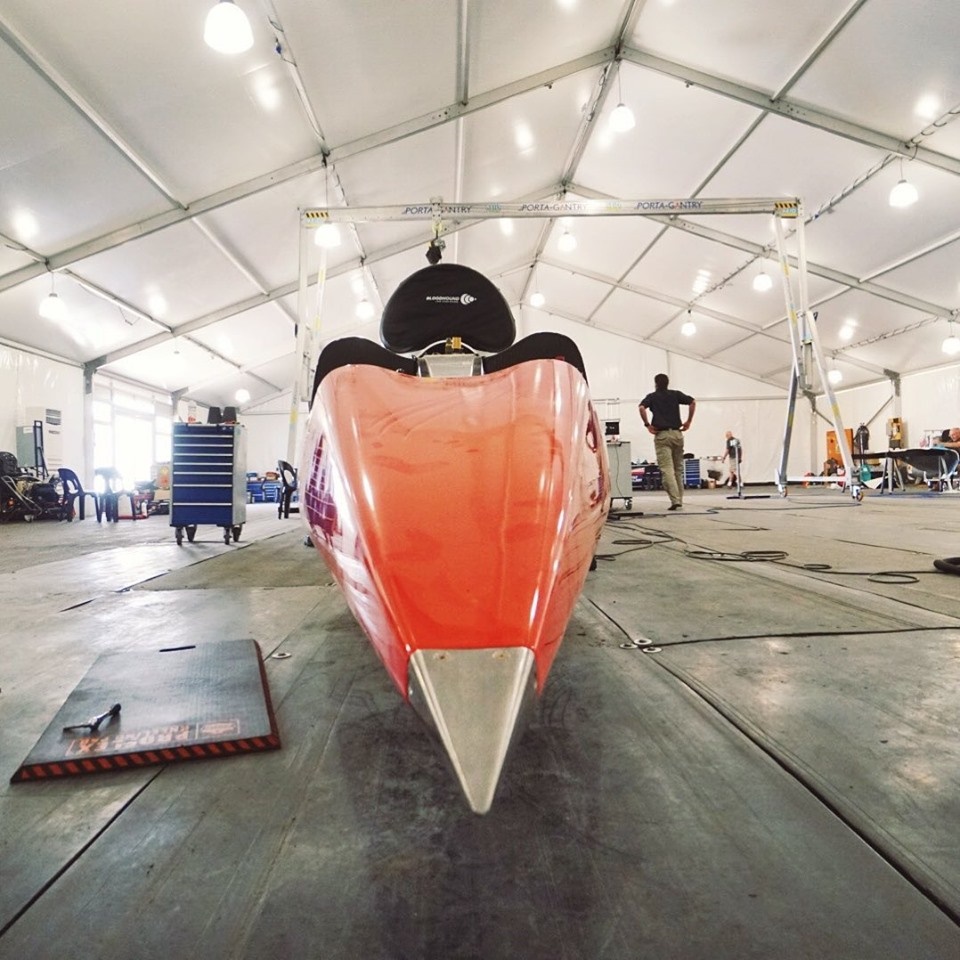
It has taken much longer than originally envisaged but the Bloodhound Land Speed Record (LSR) car and team has, at last, sniffed South African soil; arriving safely at the deserted Hakskeenpan in the Northern Cape which for the next month will be home for the team, and the setting for the car’s first high-speed test runs.
Over the weekend the Bloodhound LSR, which has travelled in a semi-dismantled state from Luxembourg to Johannesburg by airfreight before making the final 920km journey to the arid pan on the back of an articulated truck, was re-assembled and prepared for a series of runs commencing this week.
READ | Bloodhound world record run postponed... Again!
According to a media release from the team the high-speed tests will see Bloodhound blasting along a specially prepared track on Hakskeenpan for the very first time, providing a spectacular showcase of British engineering to a global audience.
The most powerful straight-line car ever was transported on the same pneumatic tyres as the car ran on in Newquay, United Kingdom, and, besides allowing the car to be manoeuvred on tarmac, they also increase damping, further protecting the car and systems from any shocks during its travels.
High-tech camp in the desert
The 25-strong team who flew out with the car joined an advance party who have been working tirelessly beneath the hot sun to set up the Desert Technical Camp on the edge of Hakskeenpan.
As well as the car itself, it houses a temporary workshop, complete with the precision tools needed to fine-tune performance and maintain the car, including a lathe, milling machine and welding equipment.
Unable to stand up to the extreme stresses of high-speed driving, these wheels were swapped out for precision-machined solid aluminium wheels for the desert runs. With these narrower wheels, made specifically for desert testing, fitted, engineers re-attached sections of carbon fibre composite bodywork to the front of the car.
Image: Bloodhound LSR
The elongated nose section, vital for effective aerodynamics, and the tail fin was also fitted, completing the chassis and making the car ready for its official unveiling today, before beginning its high-speed test programme.
During the tests, Bloodhound will build speed gradually in 80km/h increments over a month. The culmination of the tests over four to five weeks will see the car hitting mind-blowing speeds of 800+ km/h.
Bloodhound LSR driver and current World Land Speed Record holder Andy Green said that after years of work to prepare the car and following almost a decade of preparation of our desert track by the Northern Cape Government, the team is delighted to finally be here.
"The next few weeks will allow us to test the car and train the team, ready for our assault on the outright World Land Speed Record next year."
16km straight-line track
The 16km track has been prepared by 317 members of the local Mier community, funded by the Northern Cape Government. They have moved an unbelievable 16 500 tonnes of rock from 22 million square metres of dry lakebed – the largest area of land ever cleared by hand for a motorsport event.
Bloodhound CEO Ian Warhurst said the section of track the team will use is 16 km by 250m, with large safety areas on both sides. “This allows us to lay out up to 25 individual tracks side by side, if needed.
Image: Bloodhound LSR
This is important as we cannot run over the same piece of ground twice because the car will break up the baked mud surface as it passes.
"We need multiple tracks so we can build speed slowly and safely – going up in 80km/h steps, comparing real-world results with theoretical data – and Hakskeenpan is the perfect place to do this.
"The surface is hard, too, which means we have been able to design slightly narrower wheels to further reduce aerodynamic drag.
"The desert surface also has a slight degree of ‘give’, which will work with the suspension to give a smoother ride, reducing vibration inside the car," Warhurst said.
Interesting facts
The Bloodhound Land Speed Record programme is a UK-based global endeavour exploiting the cutting-edge of digital technologies to set a new World Land Speed Record and the Bloodhound LSR car is a combination of fast jet, F1 car and spaceship.
Typhoon jet engine
The high-speed testing will be conducted using the car’s Rolls-Royce EJ200 jet engine normally found in a Eurofighter Typhoon. The engine produces a peak thrust of 90 000Nm), equivalent to 34 060 thrust kW, or the combined output of 360 family cars.
At full design speed (1 690km/h) Bloodhound LSR could cover 1.6km in 3.6-seconds – that is 4 rugby fields laid end to end or 150 m per second – in the blink of an eye.
The World Land Speed Record of 1 227.9km/h is held by Thrust SSC and was set in 1997 by a UK team led by Richard Noble and driven by Bloodhound’s Andy Green.
The first target for the team is to break the world land speed record (1 227.9km/h) to understand how the car behaves as it enters the transonic stage initially and then supersonic speed levels.
If this is successfully achieved, the team will review the data and technical challenges before embarking on the challenge of safely reaching 1 609km/h.
Aluminium wheels
The solid aluminium wheels have been specially designed for the desert surface. Measuring 900mm in diameter and weighing 90kg each, they are designed to spin at up to 10 200rpm (revolutions per minute) – more than four times faster than wheels on a Formula 1 car at top speed.
The result of 30 years of research and design, they were created by an international consortium and forged from one of the highest aircraft-grade aluminium alloys in the world: 7037.
Image: Bloodhound LSR
The wheels have a V-shaped keel which digs into the baked mud surface by 15mm when the car is stationary.
As speeds increase, the wheels will rise up out of the mud surface and plane in much the same way as a speedboat rides up on the surface of the water.
At 804km/h and above just a few millimetres of metal will be in contact with the desert surface, and the giant aluminium discs will act more like rudders than the wheels on a conventional car.




 Publications
Publications
 Partners
Partners

















